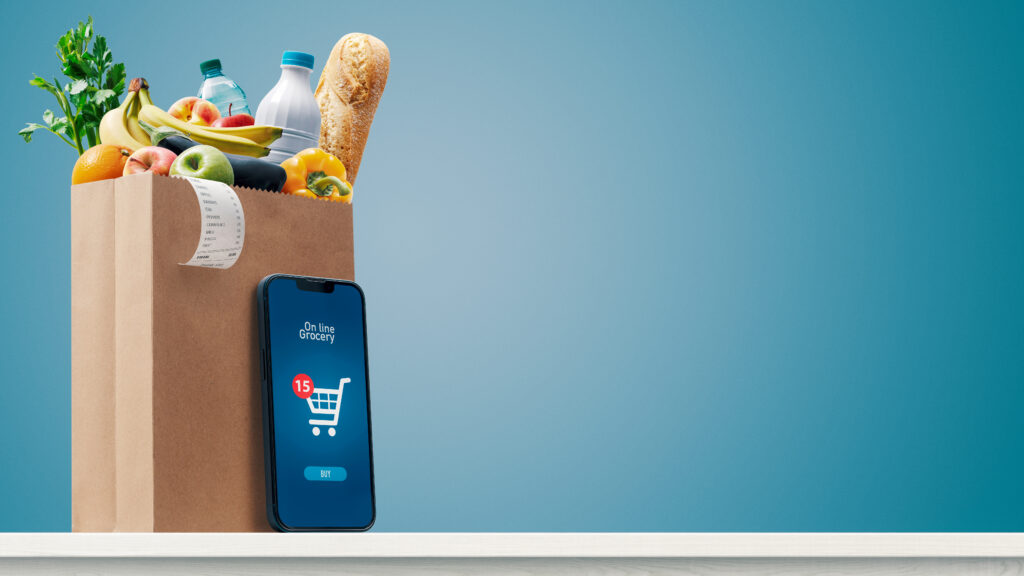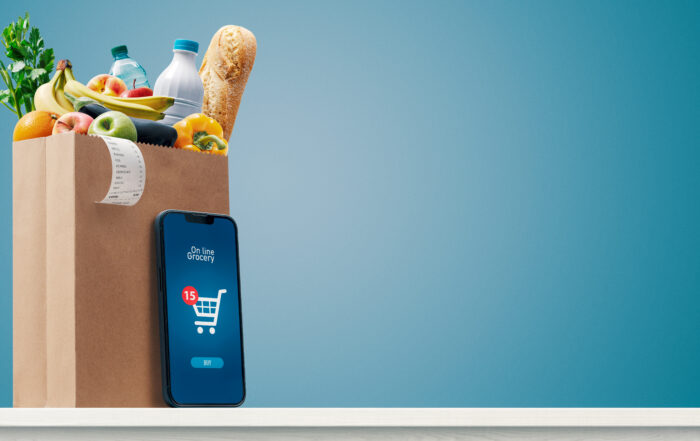
The Grocer Will Fill Your Order Now: Modernizing Online Food Shopping Becomes a Priority for Federal Agencies
By Jean Mancheno and Joanne Hawana
Introduction
Over the past three years, online grocery shopping has increased exponentially in the United States. Between 2019 and 2020, sales rose more than 50%, from $62.2 billion to $95.82 billion dollars.[1] The COVID-19 pandemic was a catalyst for this increase and enabled consumers to obtain groceries from the safety of their homes. However, the trend has continued well past the height of the pandemic, with online grocery sales projected to comprise 20% of all grocery sales by 2025. There are several features of online grocery shopping, such as efficiency, flexibility, and the ability to easily compare products, that have resulted in it becoming a preferred method amongst shoppers. Indeed, there are a breadth of digital applications and platforms, such as Amazon Fresh, InstaCart, FreshDirect, Walmart, and Peapod, that allow consumers to purchase groceries for pick up or delivery. Furthermore, in addition to its practical benefits, online grocery shopping can remove physical constraints from the shopping experience, increase one’s ability to monitor spending, and enable food access in rural areas.
Though online grocery shopping presents clear benefits for consumers, it does not come without its drawbacks. First, though online grocery shopping has increased, not all consumers in the United States are able to take advantage of its benefits. In addition, consumers report a much different experience in reviewing food labels available online compared to food labels available in a brick-and-mortar grocery store. When a consumer is shopping in a brick-and-mortar grocery store, it is common to peruse the labels of potential purchases, for both comparative purposes and to gain an understanding of their ingredients and nutritional value. The same experience is sought by consumers who are shopping for their groceries online. However, consumers have reported a much different experience when reviewing food label information online, indicating that the information may be presented inconsistently, inaccessibly, or inaccurately.
As online grocery shopping increases in the United States, there is a parallel need to improve both access and labeling, and the federal government is keen on doing so. This article will provide an overview of the federal government’s efforts to improve the online grocery shopping experience for all consumers. We will discuss the White House’s National Strategy on Nutrition and Health (National Strategy), which outlines the Biden–Harris Administration’s (Administration) plan to improve both online grocery shopping access and online food labeling.[2] We then examine efforts of various federal agencies to further the Administration’s goals. Regarding efforts of federal agencies, first, we discuss initiatives undertaken by the United States Food and Nutrition Services (FNS) to upgrade the Supplemental Nutritional Assistance Program (SNAP) and Special Supplemental Nutrition Program for Women, Infants, and Children (WIC) programs to allow for online food purchases. Second, we will review initiatives by the U.S. Food and Drug Administration (FDA) to understand and address the challenges imposed by online food label information. Finally, the article will conclude with a discussion of how these initiatives go hand-in-hand with the Administration’s overall goal of improving population health.[3]
White House Initiatives for Improving Access to Grocery Shopping and Improving Online Food Labeling
In September 2022, President Biden convened the White House Conference on Hunger, Nutrition, and Health (Conference). During the Conference, President Biden introduced the National Strategy, which is intended to address the nation’s hunger problems and promote healthier eating across the United States. Embedded in the National Strategy are plans to improve online grocery shopping and online food label information, with the White House articulating a goal of bringing “federal nutrition assistance programs into the 21st century” through expanding online shopping. Noting that online shopping has only been piloted thus far in WIC agencies, the White House commits that the United States Department of Agriculture (USDA), through funds from the American Rescue Plan Act, will expand this program to other agencies, bringing these programs beyond pilots and into permanence for shoppers (further discussed below).[4] The White House emphasizes the positive impact that this could have on marginalized communities and the elderly, who may face discrimination, stigma, increased health risks, lack of transportation or mobility, and how online shopping can improve and even enable a better shopping experience.
The National Strategy also addresses the need to improve the information found on online food labels.[5] It informs the public that FDA will publish a request for information to gather the public’s input on the industry practices, technology, and current challenges so that it can inform guidance that FDA will promulgate on the topic. This request for information, entitled Food Labeling in Online Grocery Shopping; Request for Information, was published in April 2023 and is discussed in more detail below. The White House also suggests that online grocery companies redesign their websites’ search algorithms to ensure that healthier food options will appear to their consumers, and that their offerings include ingredient and nutritional label information in an accessible manner.
On March 24, 2023, the White House renewed its commitment to these improvements and announced the Challenge to End Hunger and Build Healthy Communities.[6] In the press release for the challenge, the White House announced several initiatives geared at improving online grocery shopping and food label information. For example, in addition to announcing its intent to remove barriers from using WIC online, it announced a major partnership to offer SNAP EBT grocery delivery throughout the United States. DoorDash, an online shopping platform, will partner with local, regional, and national grocers to increase the number of healthy options and work with USDA to offer access to SNAP EBT grocery delivery in all 50 states, Washington, D.C., and Puerto Rico by 2025.
Food and Nutrition Service Enables Online Grocery Shopping for WIC and SNAP Program Beneficiaries
As mentioned above, not all consumers in the United States are able to make their grocery purchases online. In particular, individuals who use WIC and SNAP benefits are typically unable to do so because of regulatory requirements that purchases under those programs be made in person. USDA, primarily through its agency the FNS, has taken steps toward changing this paradigm. USDA has entered into a partnership with the Gretchen Swanson Center for Nutrition (GCSN) to establish the WIC Online Shopping Grant (Shopping Grant). The Shopping Grant involves two phases. First, the GCSN conducted a study to identify recommendations for implementing WIC online shopping with online and in-person transactions. The second component of the project enabled four “sub-grant” projects with funding to implement WIC online shopping programs. The sub-grant projects began in December 2021 across seven states. In Minnesota, Iowa, and Nebraska, the sub-grant was geared toward implementing an online shopping program for WIC participants at Hy-Vee grocery stores. In Washington and Massachusetts, the sub-grant was geared toward bringing online shopping to WIC participants at Walmart grocery stores. In South Dakota and for the Rosebud Sioux Tribe, an online grocery shopping program was implemented for the Buche Foods grocery store. In Nevada, the WIC agency used its sub-grant to reset the integration of the WIC online shopping using the WICShopper app.
As a result of this pilot program, FNS announced proposed regulatory changes to allow for online ordering through the WIC program on February 17, 2023. The proposed rules would remove barriers in the WIC shopping experience. Currently, WIC regulations require program participants to pick up “food instruments,” such as cash-value vouchers, Electronic Benefits Transfer (EBT) cards, and paper food instruments in person and also require WIC transactions to occur within the physical space of a store. The proposed rule would allow WIC participants to use their EBT cards with approved online grocery retailers and would also expand the program to allow for online grocery delivery, online-only retailers, and mobile grocery platform retailers. In addition to removing barriers in access to grocery shopping, it is thought that online grocery shopping will help reduce the stigma associated with receiving WIC benefits.
FNS is also focused on bringing online grocery shopping to SNAP participants as well. On July 7, 2022, FNS announced that it would award a $5 million dollar competitive grant to help expand the number of retailers offering SNAP for online shopping. Specifically, the purpose of the grant is to fund the technology and systems needed to enable SNAP recipients to shop online, to diversify the pool of stores at which SNAP beneficiaries can make purchases, and to enable smaller, independent grocery stores to provide online shopping. After an application and selection process, FNS awarded this grant to the National Grocers Association Foundation (NGAF) on January 5, 2023. The NGAF intends to use the funds to create the SNAP EBT Modernization Technical Assistance Center, enable independent community grocers to expand their online purchasing platforms, and increase online grocery shopping in rural communities across the United States.[7]
Food and Drug Administration Initiatives to Understand Food Labeling in Online Grocery Shopping
FDA has addressed the issue of food label information found on the Internet through different mechanisms over the past two decades. FDA first commented generally on the subject in response to a petition filed by the Washington Legal Foundation (WLF) in 2001. The petition, filed on April 16, 2001, requested that FDA not deem information on company websites to be “labeling,” contending that FDA regulation of website content could have negative implications on freedom of speech.[8] In FDA’s response to WLF,[9] it suggested that if a company is promoting and selling a product over the Internet, it could come within the scope of “labeling” under the Federal Food, Drug, and Cosmetic Act (FDCA) and be subject to applicable regulatory requirements.[10] FDA reiterated this point in a January 1, 2007 Dear Manufacturer Letter Regarding Food Labeling,[11] which was sent to members of the industry. Recognizing that the Internet is a valuable resource in disseminating truthful information about food to consumers, the letter encouraged manufacturers and distributors to ensure that claims about their food products posted online are consistent with FDA regulations and law.
More recently, FDA hosted the New Era of Smarter Food Safety Summit on E-Commerce: Ensuring the Safety of Foods Ordered Online and Delivered Directly to Consumers (Summit) from October 19–21, 2021. The Summit was a virtual public meeting that convened government officials from FDA, state-level health agencies, and even international health agencies to discuss topics surrounding food safety during panel sessions. Following these discussions, there was opportunity for public comment during the session and through a public docket.[12] On the Summit’s second day, there was a session on food labeling, which provided the opportunity for discussion on food labeling issues surrounding foods sold through e-commerce. During the session, panelists discussed the need for food labeling regulations to keep pace with the trends of consumers, noting the growth of online grocery ordering and current barriers to accessing nutritional facts in online shopping. The panelists noted how the location of food label information on websites is often unintuitive and that it can often be inaccurate or misleading. Commenters also pointed out that they often notice websites including disclaimers regarding the accuracy of the information provided online. They therefore encouraged FDA to issue guidance on how nutrition information should be displayed online.[13] In response, panelists from FDA reiterated their desire to gather more information from consumers and retailers to understand how food labeling in online grocery shopping could be improved.
Making good on that promise, on April 24, 2023, FDA published the notice Food Labeling in Online Grocery Shopping; Request for Information (Docket No. FDA-2023-N-0624-0002). FDA’s notice and request for information (RFI) identifies several topics related to online grocery retailers, food manufacturers, and third-party online grocery providers. The three topics, as well as the questions that FDA is seeking responses, supporting data, and evidence for, are as follows:
RFI #1: Food Labeling Information Provided Through Online Grocery Shopping
- “The mandatory label requirements on most packaged foods include, in part, nutrition information (g., Nutrition Facts label), ingredient information, and major food allergens information (when applicable). What mandatory label information is currently available through online grocery shopping platforms? How consistently is mandatory label information presented across online grocery shopping platforms?”
- “How is nutrition, ingredient, and major food allergens information presented through online grocery shopping platforms? For example, where is the information available on the webpage in relation to the product?”
- “When provided, is the nutrition, ingredient, and major food allergens information in the same format as on the packaged product (g., Nutrition Facts label format)? If pictures of the product are used, how does the manufacturer, retailer, or third-party online grocery provider ensure the information in the picture is consistent with the package label, readable, and accessible on all devices (e.g., laptops, smartphones etc.)?”
RFI #2: Industry Considerations and Logistics of Food Labeling in Online Grocery Shopping
- “Grocery foods may be sold in various ways through e-commerce, (g., directly from the manufacturer, a retailer, or through a third-party online grocery provider). How do manufacturers, grocery retailers, and third-party online grocery providers decide what label information to display for grocery foods sold through online platforms (websites, mobile applications, etc.)?”
- “What challenges and limitations do online grocery retailers, manufacturers and third-party online grocery providers encounter when seeking to display food labeling information on their respective platforms? Please provide any data and evidence to support your response. Also, what, if any, are the labeling challenges for international websites selling groceries online?”
- “How do manufacturers, retailers, and third-party online grocery providers ensure that information online is consistent with the actual product package and that the information is accurate and up to date? Please provide any data and evidence to support your response.”
- “How do online retailers and third-party online grocery providers address manufacturer reformulations that may alter a product’s nutrition, ingredient, or major food allergens information? If there is a change or error detected, how do online grocery shopping platforms collect the information and update the website (g., is there a customer feedback loop or internal quality assurance process to detect and correct online labeling errors)?”
- “What measures are online grocery shopping platforms taking to ensure that consumers can access accurate nutrition, ingredient, and major food allergens information when purchasing groceries online? Have online grocery shopping platforms identified or capitalized on opportunities to leverage online platforms (g., interactive labeling) to improve consumer engagement with and accessibility to food labeling information? Please provide any data and evidence to support your response.”
- “How are online grocery shopping platforms seeking to ensure online access to labeling information is equitable for consumers? Do current online labeling presentations present barriers to accessing labeling information for certain consumers?”
RFI #3: Consumer Use of Food Label Information in Online Grocery Shopping
- “What food label information do consumers expect to see when shopping for groceries online? For example, do consumers expect all the information presented online to be the same as the retail food package label? When there is a picture of a product label online, do consumers expect the picture of the label to be the same as the label on the retail food package?”
- “To what extent, and how, do consumers use nutrition, ingredient, and major food allergens information when grocery shopping online? For example, what percentage of consumers use the label to get information to support eating healthier? What percentage of consumers use the label information because of specific dietary concerns? We would be especially interested in demographic data on consumers who view label information when grocery shopping online.”
- “What do consumers find most challenging about navigating online shopping platforms for specific label information needs?”
- “What data are available on the most effective ways for presenting nutrition, ingredient, and major food allergens information specifically through online grocery shopping platforms (websites, mobile applications, etc.), so that consumers can easily access the information? For example, is there a specific format (g., Nutrition Facts label format) that consumers find useful in an online grocery shopping platform? What are effective means of displaying this information on the platform (e.g., link to additional product information, viewable on the top 50 percent of the web page) to ensure consumers have ready access?”
The comment period for this RFI closed on July 24, 2023, so responses from various stakeholder groups can be reviewed in the docket on Regulations.gov.[14] In total, 31 comments were electronically submitted by various stakeholders, including grocer organizations, food scientists, and individual consumers to FDA for review and consideration.
Conclusion
Several components of the federal government, including the White House, USDA, and FDA, have prioritized finding ways to empower people in the United States to make healthier, informed choices about their nutrition and food consumption. Two initiatives that can aid in this mission are increasing access to healthier foods and to nutritional information—both of which can occur through online grocery shopping.
The hope is that better access will enable consumers to identify healthier alternatives, improve diets, and, with time, lead to improved public health. A long-term goal of the White House’s National Strategy is to decrease the incidence of diet-related diseases, such as hypertension, obesity, and diabetes, which could be prevented with improved nutrition. These diseases also tend to disproportionately impact communities of color, regions with lower socioeconomic status, and rural communities.
The United States appears to be on the horizon of enacting serious regulatory reform for the WIC program, funding major projects to bring access to SNAP recipients, and better understanding the challenges in online food labeling. With the notice and comment period on FDA’s Food Labeling in Online Grocery Shopping; Request for Information closing over the summer, we can also anticipate FDA’s response and publication of guidance on the topic in the foreseeable future.[15] As a collective, in undertaking these initiatives to improve online grocery shopping and online food label information, the U.S. government is taking key steps to drive meaningful change in nutritional outcomes.
[1] eMarket Editors, In 2021, Online Grocery Sales Will Surpass $100 Billion, Insider Intelligence (Feb. 24, 2021), https://www.insiderintelligence.com/content/2021-online-grocery-sales-will-surpass-100-billion.
[2] Biden–Harris Administration National Strategy on Hunger, Nutrition, and Health, The White House (Sept. 2022), https://www.whitehouse.gov/wp-content/uploads/2022/09/White-House-National-Strategy-on-Hunger-Nutrition-and-Health-FINAL.pdf.
[3] Id.
[4] Id.
[5] Id. at 22.
[6] Fact Sheet: Biden–Harris Administration Launches the White House Challenge to End Hunger and Build Healthy Communities, Announces New Public & Private Sector Actions to Continue Momentum from Historic Hunger, Nutrition, and Health Conference, The White House (Mar. 24, 2023), https://www.whitehouse.gov/briefing-room/statements-releases/2023/03/24/fact-sheet-biden-harris-administration-launches-the-white-house-challenge-to-end-hunger-and-build-healthy-communities-announces-new-public-private-sector-actions-to-continue-momentum-from-hist/.
[7] NGA Foundation Awarded $5M USDA Grant to Advance SNAP Online Programs, Winsight Grocery Bus. (Jan. 5, 2023), https://www.winsightgrocerybusiness.com/industry-partners/nga-foundation-awarded-5m-usda-grant-advance-snap-online-programs.
[8] Washington Legal Foundation – Citizen Petition, U.S. Food & Drug Admin. (Apr. 16, 2001), https://www.regulations.gov/document/FDA-2001-P-0321-0001.
[9] FDA/Associate Commissioner for Policy Response to the Washington Legal Foundation – Petition Denial, U.S. Food & Drug Admin. (Nov. 1, 2001), https://www.regulations.gov/document/FDA-2001-P-0321-0003.
[10] The FDCA defines “labeling” as “all labels and other written, printed, or graphic matter (1) upon any article or any of its containers or wrappers, or (2) accompanying such article.” 21 U.S.C. § 321(m). Federal courts, including the Supreme Court, have upheld a broad application of the phrase “accompanying such article” to mean more than physical association with the product, such that it extends to materials like posters, brochures, and other advertisements so long as they have been created by or on behalf of the product’s manufacturer with the intent of “accompanying” the product in commerce. Since the 2001 WLF petition response, the concept of manufacturers’ websites as promotional labeling for their products has become embedded in various agency policies.
[11] Guidance for Industry and FDA: Dear Manufacturer Letter Regarding Food Labeling, U.S. Food & Drug Admin. (Jan. 2007), https://www.fda.gov/regulatory-information/search-fda-guidance-documents/guidance-industry-and-fda-dear-manufacturer-letter-regarding-food-labeling.
[12] FDA New Era of Smarter Food Safety Summit on E-Commerce; Public Meeting; Request for Comments, U.S. Food & Drug Admin. (Oct. 19, 2021), https://www.regulations.gov/docket/FDA-2021-N-0929.
[13] Transcript: New Era of Smarter Food Safety Summit on E-Commerce – Day 2 (October 20, 2021), U.S. Food & Drug Admin. 147–55 (Oct. 20, 2021), https://www.fda.gov/media/154860/download.
[14] The electronic comments that FDA received on the docket can be viewed at https://www.regulations.gov/document/FDA-2023-N-0624-0002/comment.
[15] On July 6, 2023, FDA updated the list of guidance documents that it is intending to promulgate or revise by the end of December 2023. Guidance addressing food labeling in online grocery shopping is not included on this list. However, FDA is not precluded from issuing a guidance document on topics not included prior to December 2023. See Food Program Guidance Under Development, U.S. Food & Drug Admin. (July 6, 2023), https://www.fda.gov/food/guidance-documents-regulatory-information-topic-food-and-dietary-supplements/foods-program-guidance-under-development.
Update Magazine
Fall 2023

 JEAN MANCHENO is an Associate at Mintz, Levin, Cohn, Ferris, Glovsky and Popeo, P.C. where her practice spans across a variety of health care and FDA matters. She regularly provides counsel on transactional, regulatory, and enforcement defense matters to clients in the health care, pharmaceutical, and medical device industries.
JEAN MANCHENO is an Associate at Mintz, Levin, Cohn, Ferris, Glovsky and Popeo, P.C. where her practice spans across a variety of health care and FDA matters. She regularly provides counsel on transactional, regulatory, and enforcement defense matters to clients in the health care, pharmaceutical, and medical device industries. JOANNE HAWANA is a Member at the law firm of Mintz, Levin, Cohn, Ferris, Glovsky and Popeo, practicing in the Health Law/FDA Group and based in the firm’s Washington, D.C. office. She counsels global clients on the business impact of new U.S. federal and state actions related to drugs, biologics, cellular therapies, foods, cosmetics, and medical devices.
JOANNE HAWANA is a Member at the law firm of Mintz, Levin, Cohn, Ferris, Glovsky and Popeo, practicing in the Health Law/FDA Group and based in the firm’s Washington, D.C. office. She counsels global clients on the business impact of new U.S. federal and state actions related to drugs, biologics, cellular therapies, foods, cosmetics, and medical devices.





